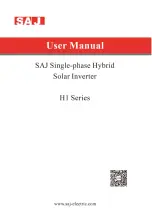
36 | SAMLEX AMERICA INC.
Clean: The area should be free of dust and fumes. Ensure that there are no insects or
rodents. They may enter the unit and block the ventilation openings or short circuit
electrical circuits inside the unit.
Protection against fire hazard: The unit is not ignition protected and should not be
located under any circumstance in an area that contains highly flammable liquids like
gasoline or propane as in an engine compartment with gasoline-fueled engines. Do not
keep any flammable / combustible material (i.e., paper, cloth, plastic, etc.) near the unit
that may be ignited by heat, sparks or flames.
Closeness to the battery bank: Locate the unit as close to the battery bank as possible
to prevent excessive voltage drop in the battery cables and consequent power loss and
reduced efficiency. However, the unit should not be installed in the same compartment
as the batteries (flooded or wet cell) or mounted where it will be exposed to corrosive
acid fumes and flammable Oxygen and Hydrogen gases produced when the batteries
are charged.
The corrosive fumes will corrode and damage the unit and if the gases are not venti-
lated and allowed to collect, they could ignite and cause an explosion.
Accessibility: Do not block access to the front panel. Also, allow enough room to access
the AC receptacles and DC wiring terminals and connections, as they will need to be
checked and tightened periodically.
Preventing Radio Frequency Interference (RFI): The unit uses high power switching
circuits that generate RFI. This RFI is limited to the required standards. Locate any elec-
tronic equipment susceptible to radio frequency and electromagnetic interference as far
away from the inverter as possible. Read Section 3 “Limiting Electromagnetic Interference
(EMI)” for additional information.
8.2 MOUNTING ORIENTATION
The unit has air intake and exhaust openings for the cooling fan. It has to be mounted
in such a manner so that small objects should not be able to fall easily into the unit from
these openings and cause electrical / mechanical damage. Also, the mounting orienta-
tion should be such that if the internal components overheat and melt / dislodge due to
a catastrophic failure, the melted / hot dislodged portions should not be able to fall out
of the unit on to a combustible material and cause a fire hazard. The size of openings
has been limited as per the safety requirements to prevent the above possibilities when
the unit is mounted in the recommended orientations. In order to meet the regulatory
safety requirements, the mounting has to satisfy the following requirements:
SECTION 8 |
Installation
















































